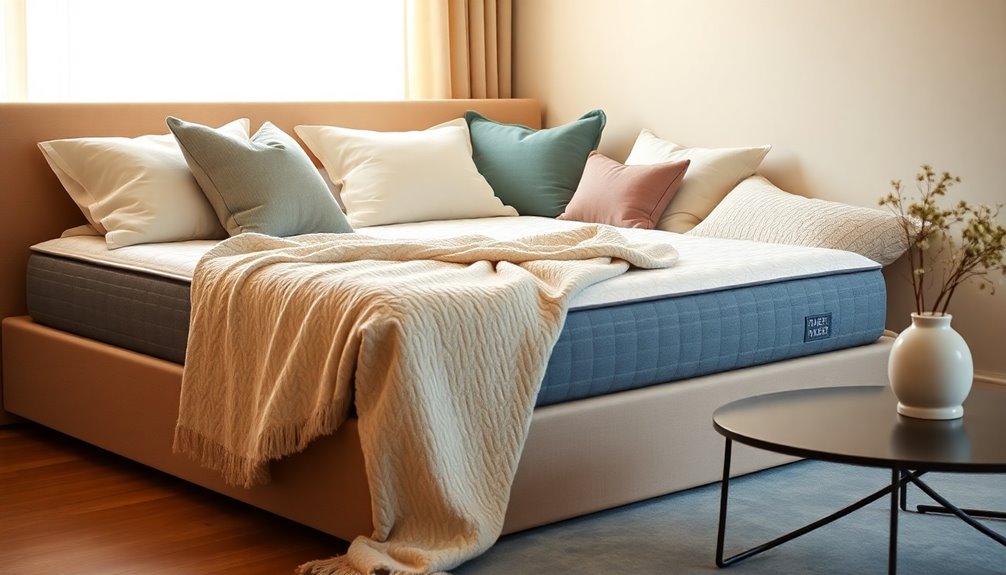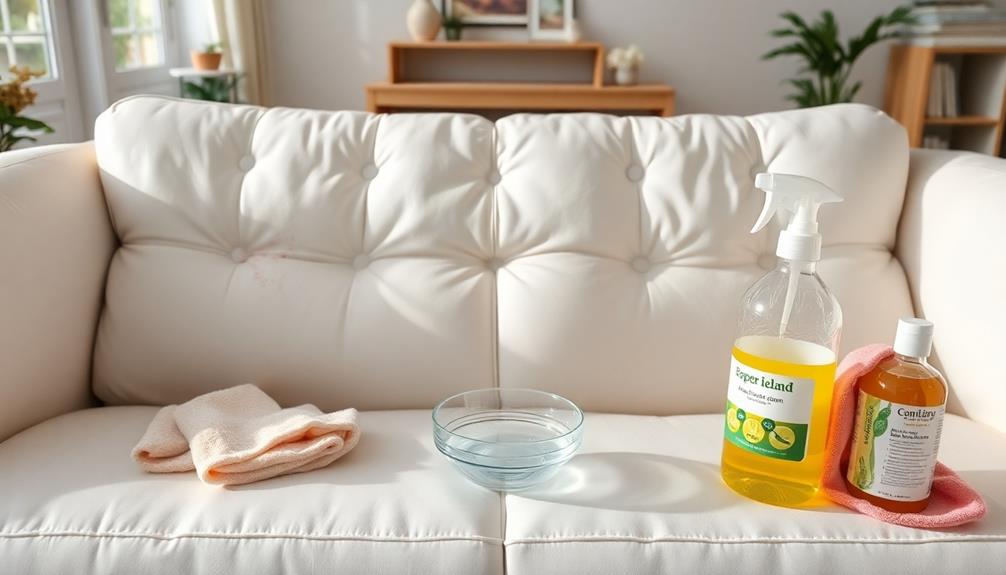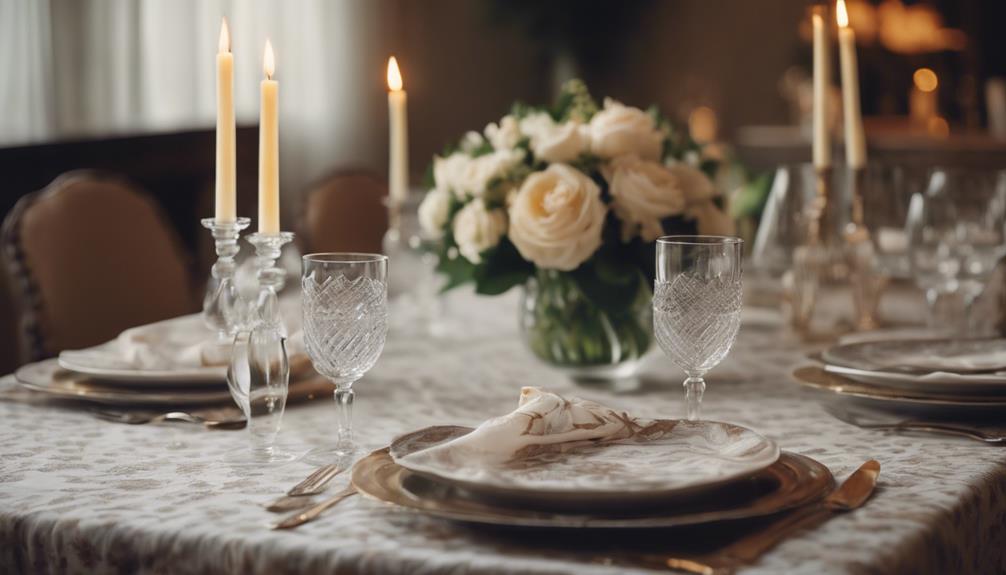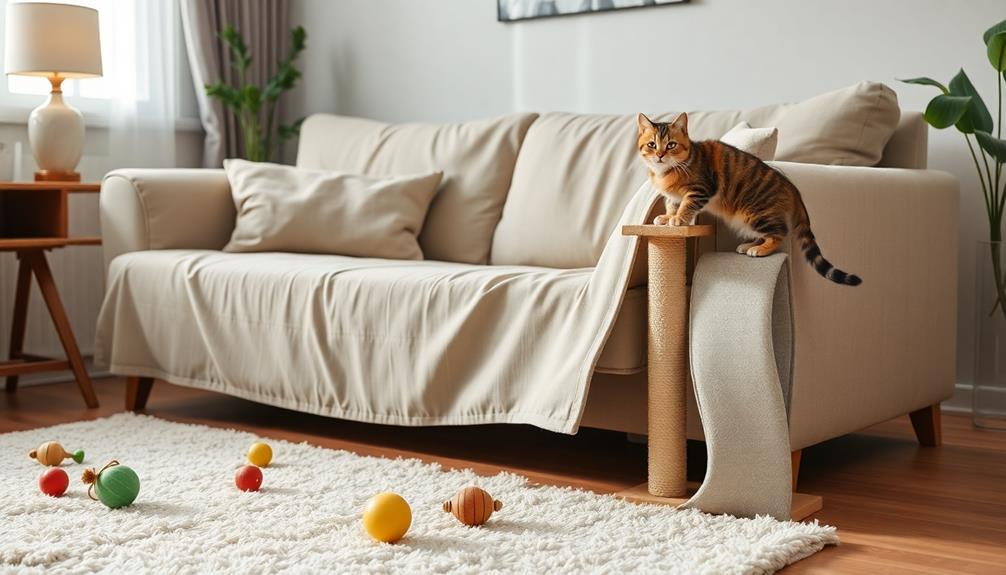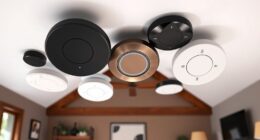To make a queen mattress into a sofa, start by placing it on a sturdy frame or platform at the desired height. You can use decorative throw pillows for back support and comfort. For a finished look, consider adding a slipcover to match your décor. To protect your mattress, keep it out of direct sunlight and regularly check the upholstery for wear. Use cushions with adjustable firmness for added comfort. With some simple enhancements and maintenance, you'll have a cozy sofa that fits your space. Discover how to elevate your mattress sofa setup with these easy tips!
Key Takeaways
- Choose a sturdy, supportive frame or platform to elevate the queen mattress for sofa-like seating.
- Add decorative pillows and throws to enhance comfort and style, making the setup inviting.
- Incorporate a slipcover or upholstery fabric to protect the mattress and create a cohesive look.
- Use a low-profile coffee table or ottoman in front of the mattress for functionality and convenience.
- Ensure proper ventilation and cleanliness by regularly vacuuming and maintaining the mattress to prevent odors and allergens.
Introduction
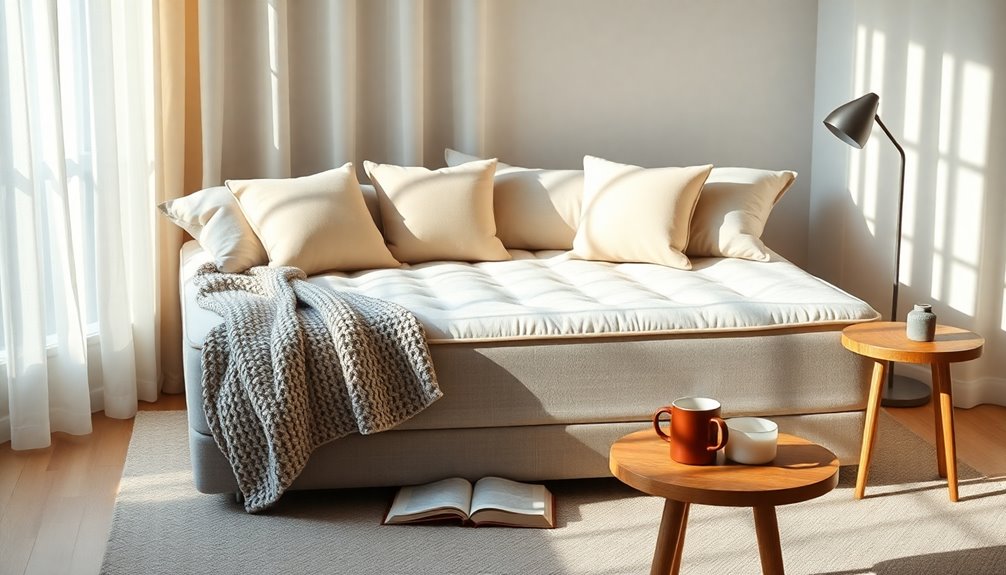
When you convert your queen mattress into a sofa, keeping it clean is essential for comfort and longevity. Regular vacuuming and dusting can help maintain the fabric, while specific cleaning techniques tackle stains effectively. If you've got pets, knowing how to eliminate urine stains will ensure your new sofa stays fresh and inviting.
Routine Vacuuming and Dusting
Maintaining a clean mattress sofa is essential for a healthy living space, so regular vacuuming and dusting should be part of your routine. By vacuuming your mattress sofa at least once a month, you'll effectively remove dust, allergens, and debris that can accumulate over time. Use a vacuum cleaner with an upholstery attachment to ensure you get into the fabric covering and the crevices of the sofa. This thorough cleaning contributes to a healthier living environment for you and your guests.
Don't forget to dust the surrounding area, including any decorative pillows or throws. This helps prevent dust buildup and keeps your mattress sofa looking fresh and inviting. For optimal results, consider using a fabric-safe cleaner or spray after vacuuming. This not only refreshes the material but also eliminates any lingering odors.
Fabric-Specific Cleaning Techniques
Keeping your mattress sofa clean goes beyond routine vacuuming and dusting; it also involves using the right cleaning techniques for the specific fabric. If your mattress sofa has upholstery fabric, mix mild detergent with water and use a soft brush to gently scrub away stains, being careful not to soak the material. For leather coverings, simply wipe down the surfaces with a damp cloth and follow up with a leather conditioner to keep it supple and prevent cracking.
If your mattress sofa is made of microfiber, create a solution of equal parts vinegar and water. Apply it with a sponge to lift dirt without using harsh chemicals that could damage the fibers. Always check the manufacturer's care label for specific cleaning instructions, as different fabrics have unique requirements. Additionally, using energy-efficient options for your cleaning equipment can help reduce overall utility costs while maintaining a clean environment.
For removable fabric covers, machine wash them on a gentle cycle using cold water and mild detergent, then air dry to maintain their shape and prevent shrinkage. By tailoring your cleaning approach to the fabric of your mattress sofa, you'll keep it looking fresh and extend its lifespan.
Eliminating Pet Urine Stains
Eliminating pet urine stains from your queen mattress sofa can feel daunting, but acting quickly makes all the difference. Start by promptly blotting the area with paper towels to absorb as much liquid as possible before it seeps deeper into the fabric. Once you've done that, create a solution using equal parts white vinegar and water, and spray it onto the stained area. Let it sit for 10-15 minutes; this helps neutralize odors and break down the stain.
Next, sprinkle baking soda over the treated area to absorb moisture and odors. Allow it to sit for several hours or overnight for the best results. Once settled, vacuum the baking soda off. If any stain remains, don't hesitate to repeat the vinegar and baking soda treatment until the stain is fully removed.
For particularly stubborn stains, consider using an enzymatic cleaner specifically designed for pet stains. These products work by breaking down the proteins in urine, tackling both lingering odors and discoloration. With these steps, your mattress and box will be fresh again, and your sofa will look as good as new!
Avoid Direct Sunlight Exposure
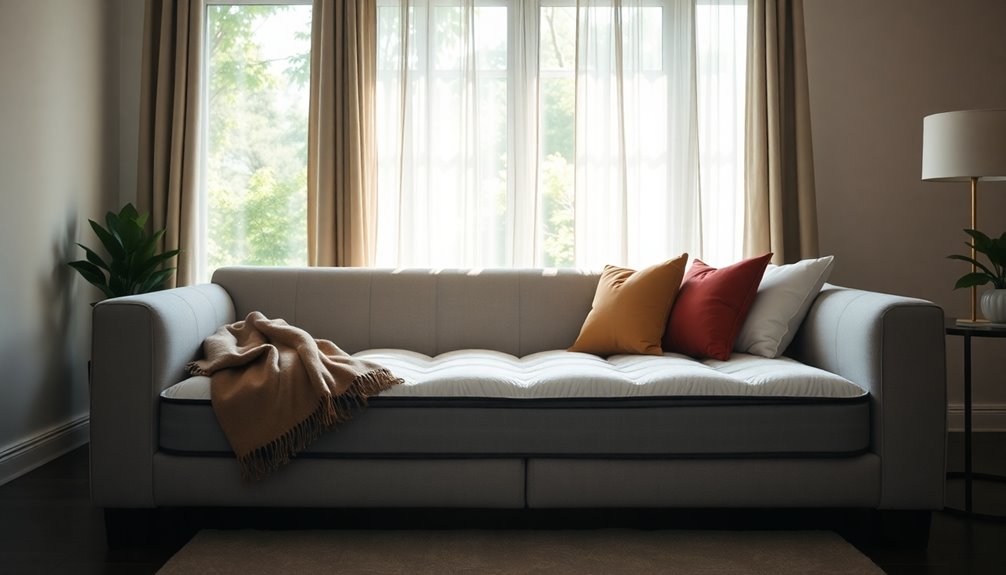
When you're transforming your queen mattress into a sofa, it's essential to protect it from direct sunlight. Not only can UV rays fade your fabric, but they can also weaken the materials over time. By choosing durable, scratch-resistant fabrics and using washable covers, you can keep your sofa looking great while ensuring it stands up to everyday wear.
Use Durable, Scratch-Resistant Fabric
Durability is key when transforming a queen mattress into a sofa, especially if you want it to withstand daily use. When selecting fabric, opt for materials like polyester or canvas that are both durable and scratch-resistant. These fabrics resist wear from everyday activities, ensuring your sofa remains in good shape over time.
It's also wise to look for UV-resistant options. This can prevent fading and degradation caused by direct sunlight, prolonging the life of your sofa significantly. Outdoor-grade fabrics are a great choice, as they're designed to endure the elements and are typically more resilient to stains and scratches.
For enhanced durability, choose fabrics weighing at least 8 oz per square yard. This weight provides better resistance against wear and tear, making your sofa more reliable. Additionally, regularly rotating and fluffing the cushions covered in durable fabric will help maintain their shape and comfort, ensuring they can handle frequent use without losing their appeal.
Opt for Washable Fabric Covers
Frequently opting for washable fabric covers is a smart choice for your queen mattress sofa. These covers make maintenance a breeze, allowing you to quickly clean spills or stains without damaging the mattress underneath. When selecting washable fabric covers, choose durable materials like heavy-duty cotton or polyester blends. These fabrics can handle regular use and frequent washing without losing their shape or integrity.
To keep your sofa looking fresh, avoid direct sunlight exposure on your fabric covers. Sunlight can lead to fading and deterioration, which affects the overall aesthetic appeal of your sofa. Additionally, consider removable covers with zippers or Velcro for convenience. This design makes it simple to take off and wash the fabric whenever necessary.
Regularly vacuum your washable fabric covers to eliminate dust and allergens. This practice not only helps maintain a clean seating area but also prolongs the life of the fabric. By taking these steps, you ensure your queen mattress sofa remains comfortable, stylish, and ready for use, all while being easy to care for. Embracing washable fabric covers is a practical investment in your home.
Using Furniture Protectors
To keep your queen mattress sofa looking its best, using furniture protectors is essential. These protectors, like slipcovers or fabric protectants, shield the mattress from daily wear and tear. First, consider choosing UV-resistant fabric for your covers to minimize sunlight damage. This helps keep the colors vibrant longer and protects against fading.
Position your sofa away from windows whenever possible. If that's not an option, use curtains or blinds to reduce direct sunlight exposure. This simple adjustment can significantly extend the lifespan of your mattress sofa. Additionally, regularly rotate the mattress to ensure even wear and prevent uneven fading over time.
You might also want to add a protective layer, such as a moisture-wicking mattress cover. This not only guards against spills and stains but also enhances durability, keeping your mattress in great shape for longer. By investing in quality furniture protectors and being mindful of your sofa's placement, you can enjoy a stylish and functional piece that stands up to the test of time. Protecting your mattress sofa will ensure it remains a cozy and inviting part of your home.
Upholstery Fabric Inspection
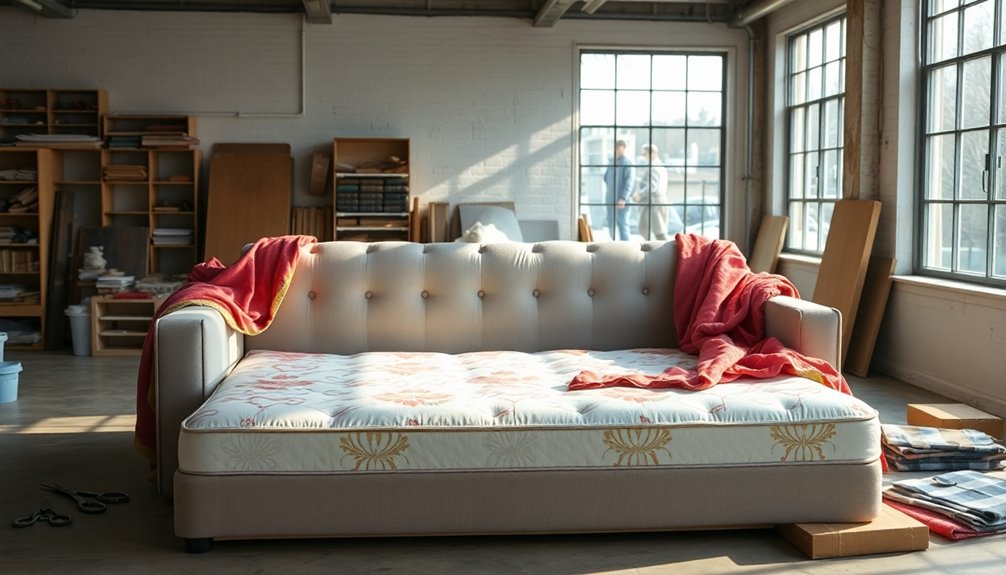
When you inspect upholstery fabric, pay attention to the integrity of the frame and any worn leather sections that may need reupholstering. You'll also want to ensure the fabric revitalizes both softness and support for your new sofa. These factors are crucial for creating a comfortable, durable piece that lasts. Additionally, regular preventive maintenance can help keep your sofa in optimal condition over time.
Frame Integrity Concerns
Before diving into converting your queen mattress into a sofa, it's crucial to inspect the upholstery fabric closely. You need to look for signs of wear, like fraying seams or discoloration, which could affect both the aesthetics and durability of your new sofa. Frame integrity concerns can arise if the fabric isn't up to the task. Check for any tears or holes that may need repair before you start using the mattress as a sofa. You want to ensure that the upholstery can withstand regular use.
Consider the material of the upholstery as well. Ideally, it should be durable, made from heavy cotton or canvas that resists wear and tear. Don't overlook any signs of mold or mildew, as these indicate moisture damage that could lead to further deterioration of both the mattress and the fabric. If you find issues, you might want to apply a fabric protector after making necessary repairs, enhancing its longevity and resistance to stains and spills. By addressing these frame integrity concerns upfront, you'll ensure your sofa is not only visually appealing but also functional for everyday use.
Reupholstering Worn Leather Sections
Inspecting the worn leather sections of your mattress is essential for a successful reupholstering project. Start by thoroughly checking for cracks, tears, and thinning areas to gauge the extent of the damage. This will help you decide how to proceed with your reupholstering efforts.
Once you've assessed the condition, choose a high-quality upholstery fabric that complements the existing leather and is durable enough to handle regular use. Before applying this new fabric, clean the leather surface with a suitable leather cleaner and conditioner. This ensures better adhesion and a smoother finish when you start reupholstering.
When it's time to attach the new upholstery fabric, use a staple gun or strong adhesive to secure it over the worn leather sections. Make sure it's tight and smooth to prevent sagging, which could affect both aesthetics and comfort. If you notice that the underlying structure needs extra support, consider adding a layer of foam or batting before applying the upholstery fabric. This step will enhance both the comfort and durability of your newly transformed sofa.
Revitalizing Softness and Support
To ensure your newly upholstered sofa offers both softness and support, you'll need to carefully inspect the upholstery fabric you choose. Start by checking the weight and thread count; heavier fabrics typically resist wear and tear better over time. Look for fabrics with a high rub count, ideally above 15,000, to indicate resistance to abrasion, which helps maintain the sofa's appearance.
Make sure the fabric is specifically labeled for upholstery, as some materials won't withstand the stress of daily use. Consider the cleaning requirements, too; opting for stain-resistant and washable fabrics can prolong the life of your converted sofa and make maintenance easier.
Evaluate the fabric's texture and breathability to ensure comfort. Softer, more breathable materials enhance the overall lounging experience, especially when combined with a quality memory foam layer for added support. This combination will not only revitalize your old mattress but will also create a cozy seating area. By taking the time to inspect these details, you'll guarantee your new sofa is both inviting and durable, perfect for relaxing or entertaining guests.
Changing Cushion Firmness Options
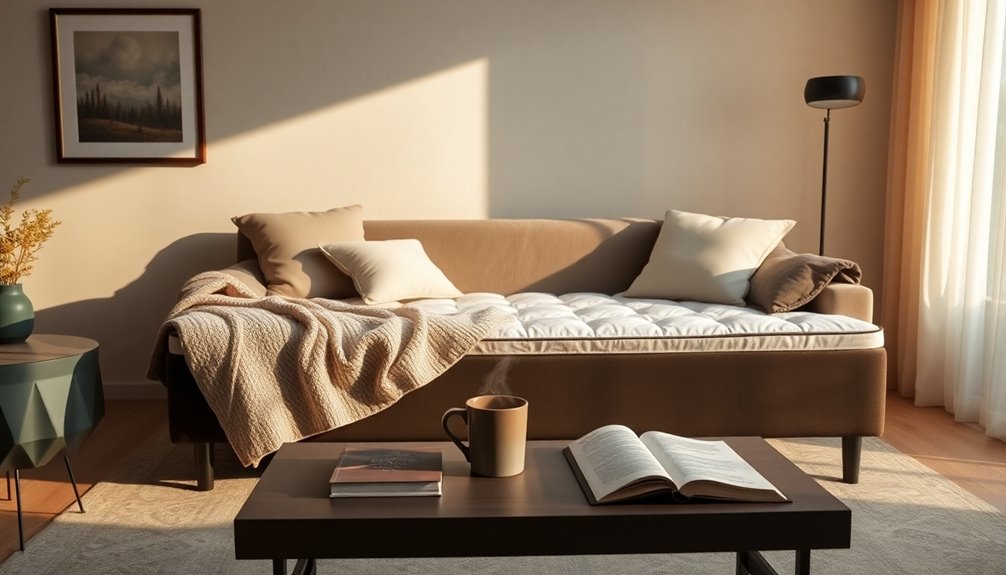
When converting a queen mattress into a sofa, adjusting the cushion firmness can significantly enhance your seating experience. To achieve the perfect level of comfort, consider using different types of foam padding. Memory foam offers a soft, cozy feel, while high-density foam provides a firmer support that many appreciate. You can create a customized seating experience by adding or removing layers of foam or varying their thickness.
Additionally, look for cushions with adjustable firmness, such as those with removable covers filled with polyester or down. This allows you to easily modify your seating to match personal preferences. Experimenting with the arrangement of existing cushions can also impact firmness. For example, stacking firmer cushions behind softer ones can create a supportive backrest while maintaining overall comfort.
Lastly, don't forget to regularly rotate or flip the cushions you use on the mattress. This simple practice helps maintain their shape and cushion firmness over time, ensuring consistent comfort for everyone who sits on your newly converted sofa. By making these adjustments, you'll create a versatile and inviting seating area that meets your needs.
Seasonal Storage Solutions

Effective seasonal storage solutions can transform your queen mattress sofa into a clutter-free and organized space. Start by storing seasonal items like bedding and decorative pillows inside vacuum-sealed bags. This minimizes space usage and protects your belongings from dust and moisture. Under-bed storage containers work wonders too; they help keep extra cushions or blankets organized and easily accessible without crowding your living area.
Another great idea is to use a storage ottoman or footstool. These pieces can double as seating or a table while providing hidden storage for seasonal items when your mattress is converted into a sofa. Don't forget about your seasonal decor—rotate and store it in labeled bins. This makes it easy to refresh your sofa area throughout the year.
To maximize vertical space, consider installing shelves above the sofa. These shelves can hold seasonal items, freeing up your floor space and keeping everything tidy. Implementing these solutions aligns with the idea of creating designated zones for specific activities or items, ensuring your space remains functional and inviting. By implementing these seasonal storage solutions, you'll create a functional and inviting space that accommodates your needs while ensuring your queen mattress sofa remains an attractive centerpiece in your home.
Conclusion
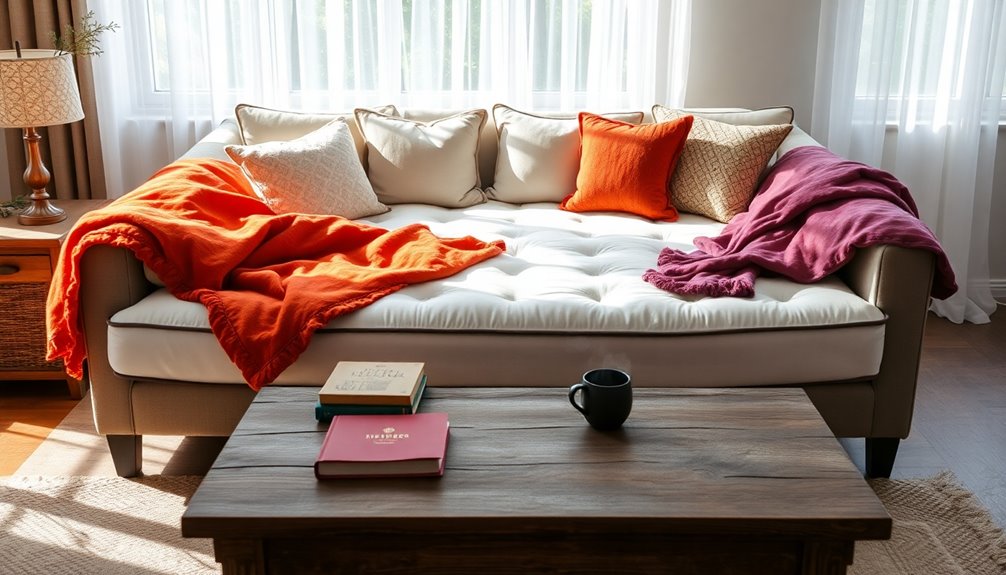
Converting a queen mattress into a sofa is a smart, cost-effective solution that maximizes your living space. Not only do you save money, but you also contribute to a more sustainable environment by repurposing an old mattress instead of throwing it away. By using plywood or wooden pallets as a base and adding cushions for back support, you'll ensure your new sofa is both comfortable and stable.
The process is straightforward: measure and cut fabric to fit the mattress, secure it with staples or adhesive, and add foam padding for extra comfort. Don't forget to incorporate a slipcover or choose creative fabric options to customize the design, allowing your mattress sofa to blend seamlessly with your existing decor.
To keep your queen mattress sofa in top shape, regular maintenance is key. Vacuuming and checking for wear will ensure it remains safe and cozy for daily use. In conclusion, this innovative project not only transforms your mattress into functional seating but also helps you create a unique, personalized piece that enhances your living space. Enjoy your stylish and practical new sofa!
Frequently Asked Questions
Can You Make a Sofa Out of a Mattress?
Yes, you can definitely make a sofa out of a mattress! Start by laying the mattress flat and adding cushions or pillows for back support. To improve its look and durability, wrap it in fabric or a slipcover. A stable base, like plywood or wooden pallets, can elevate the mattress and enhance comfort. Finally, throw in some decorative pillows and blankets to create an inviting and cozy seating area. It's a fun DIY project!
How to Use a Mattress as a Sofa?
To use a mattress as a sofa, start by positioning it against a wall for support. You can wrap it in a durable fabric or slipcover to enhance its look. Add cushions and pillows as backrests for comfort, layering them for a cozy vibe. Don't forget to accessorize with a throw blanket and side tables for convenience. Regularly check for wear and tear, keeping it clean with vacuuming and spot cleaning as needed.
How to Make a Queen Size Bed Into a Daybed?
To make a queen size bed into a daybed, start by positioning the mattress against a wall. This creates a supportive backrest. Use a fitted sheet or stylish cover for a polished look, and add decorative pillows and a cozy throw blanket for comfort. If you want more height, consider placing the mattress on a low platform or wooden pallets. Regularly check the mattress for cleanliness, ensuring it's comfy for lounging or sleeping.
How Thick of a Mattress Can You Put on a Sofa Bed?
When considering a mattress for your sofa bed, you should aim for a thickness between 4 to 8 inches. This range ensures that the mattress folds properly and maintains comfort when used as a sofa. While memory foam can compress better, sticking to around 6 inches is ideal. Don't forget to check the weight limits of your sofa bed frame, as thicker mattresses can add extra weight and affect stability.
